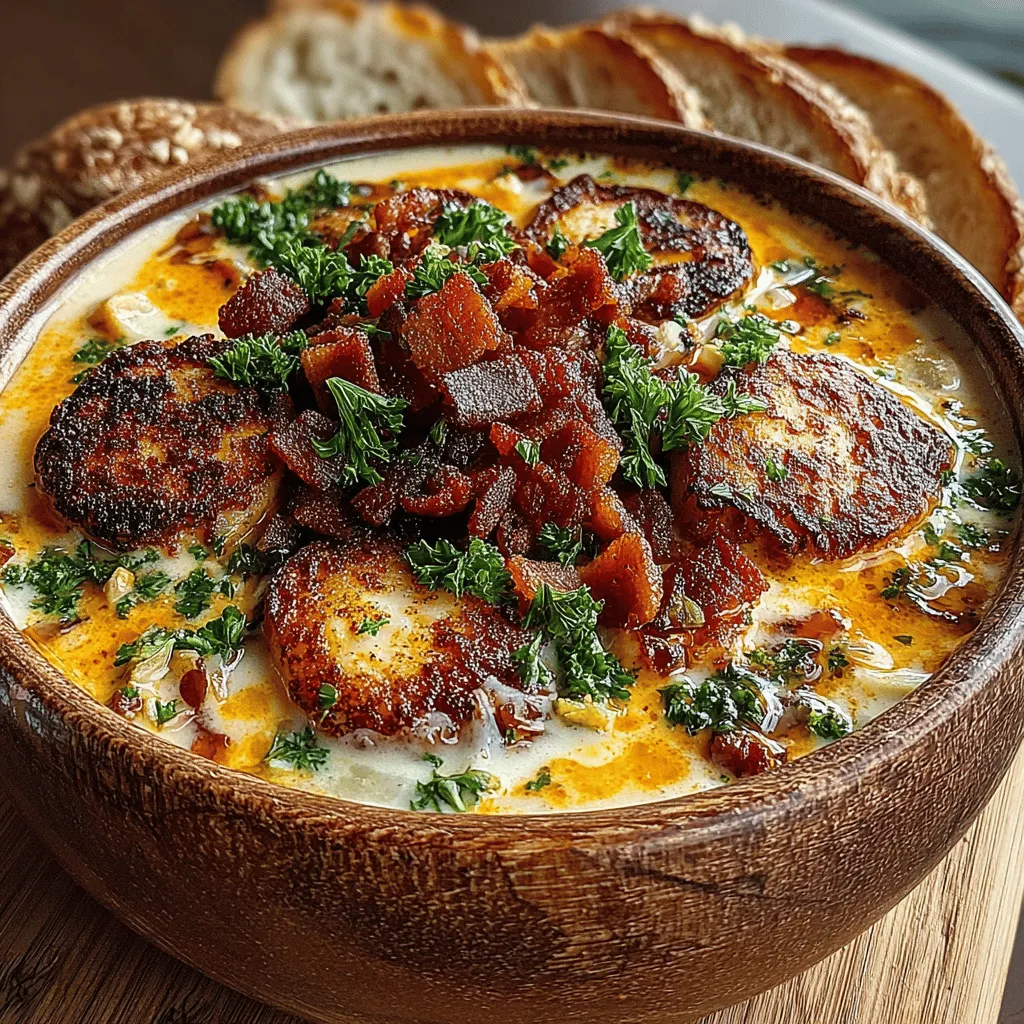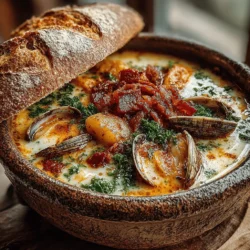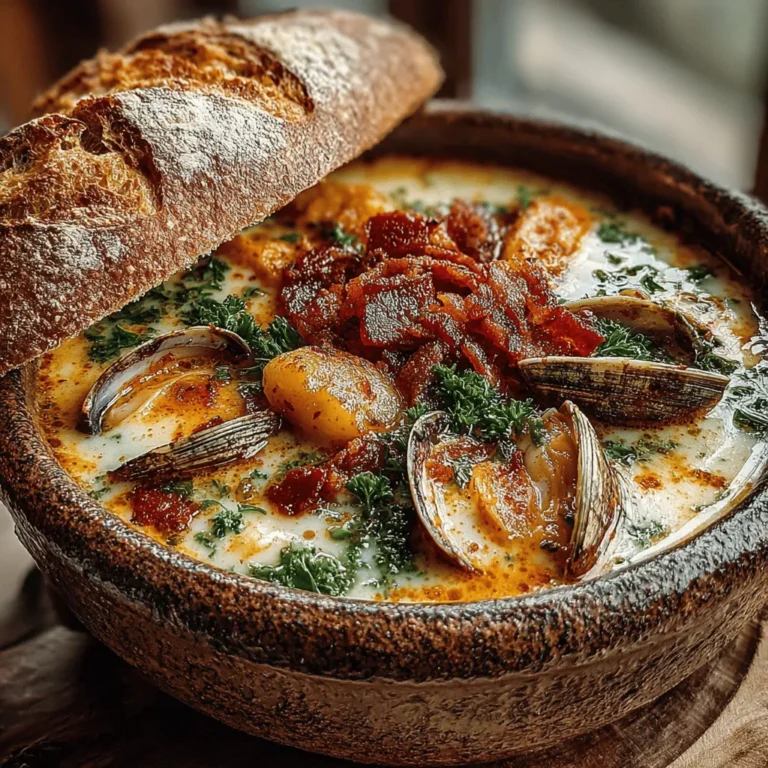Creamy Classic New England Clam Chowder: A Timeless Recipe
New England clam chowder is more than just a dish; it is a cultural icon that embodies the rich culinary heritage of the northeastern United States. Originating in the coastal towns of New England, this hearty soup reflects the region’s maritime history, where fresh seafood was abundant and integral to the local diet. The roots of clam chowder can be traced back to the 18th century, with its earliest versions likely being simple broths made by early settlers. Over the years, the recipe has evolved, giving rise to the creamy, robust version that many have come to love today.
What sets this creamy clam chowder apart is its indulgent blend of flavors and textures that comfort the soul. Each spoonful brings a delightful mix of briny clams, smoky bacon, and tender potatoes, all enveloped in a luxurious, creamy broth. It’s this combination that has secured clam chowder a special place in the hearts of food lovers, making it a staple at family gatherings, holiday feasts, and seaside restaurants alike. Furthermore, its straightforward preparation makes it accessible for home cooks, inviting them to recreate a taste of New England in their kitchens.
Understanding the Ingredients
To craft the perfect New England clam chowder, it’s essential to understand the role of its key ingredients. The star of the dish is undoubtedly the clams. Fresh clams, if available, offer a briny sweetness that canned clams simply cannot replicate. However, using canned clams can still yield a delicious chowder, especially when fresh options are not feasible.
Bacon plays a crucial role in this recipe, imparting a smoky depth of flavor that elevates the overall taste profile. The fat rendered from the bacon not only adds richness but also serves as the base for sautéing the aromatic vegetables that follow.
The vegetable base typically consists of onions, garlic, and celery, which form the aromatic foundation of the chowder, while diced potatoes contribute heartiness and texture. Yukon Gold or Russet potatoes are often preferred for their creamy consistency when cooked.
Dairy is another essential element; a combination of heavy cream and whole milk creates the signature creamy texture that New England clam chowder is known for. The creaminess balances the flavors and makes each bite velvety smooth. For those with dietary preferences or sensitivities, variations can include using plant-based milk or vegetable broth to lighten the dish without sacrificing flavor.
Preparation Steps Explained
Now that we have a clear understanding of the ingredients, let’s delve into the preparation process, which is key to achieving a well-balanced and flavorful chowder.
Cooking the Bacon:
Start by heating a large pot or Dutch oven over medium heat. Once hot, add diced bacon and cook until it is crispy, stirring occasionally to ensure even cooking. The goal is to render the fat and achieve a golden-brown color. This process usually takes about 5 to 7 minutes. Once cooked, remove the bacon from the pot, leaving the rendered fat behind. This fat will serve as the flavor base for the chowder.
Sautéing Vegetables:
With the bacon fat still in the pot, add diced onions and sauté them until they become translucent, about 3 to 4 minutes. Next, add minced garlic and diced celery, cooking for an additional 2 minutes. This step is crucial as it develops the foundational flavors of the chowder. The aroma of the sautéing vegetables combined with the bacon fat creates a fragrant base that will enhance the overall dish.
Combining Ingredients:
Once the vegetables are tender, it’s time to incorporate the diced potatoes and cooked bacon back into the pot. Stir everything together, allowing the ingredients to mingle for a minute or two. This layering of flavors is essential for a delicious final product. Next, pour in the clam juice (if using canned clams, this will be included in the can) and enough water or stock to cover the vegetables. Bring the mixture to a boil, then reduce the heat to a simmer.
Simmering with Clams:
After the chowder base has come to a simmer, it’s time to add the clams. If using fresh clams, ensure they are scrubbed clean and checked for any dead ones. Add them to the pot and cover, allowing them to steam for about 5 to 10 minutes, or until they open. This is crucial; clams that remain closed should be discarded, as they are not safe to consume.
As the clams cook, the broth will absorb their natural briny flavor, enriching the chowder. During this stage, keep an eye on the potatoes. They should be fork-tender but not mushy. Once the clams have opened and the potatoes are cooked, it’s time to finish the chowder with the final touches.
Finishing Touches:
To achieve that creamy consistency, stir in the heavy cream and whole milk. Allow the chowder to warm through, but avoid boiling after adding the dairy to prevent curdling. Taste and adjust seasoning with salt and freshly cracked black pepper as needed. If desired, sprinkle in fresh herbs like thyme or parsley for added flavor and a touch of color.
As you embark on this culinary journey, remember that the beauty of New England clam chowder lies not only in its sumptuous flavors but also in the memories it creates. From cold winter nights to summer seaside picnics, this dish is a reminder of the simple pleasures that come from good food and shared experiences.

Enhancing Flavor with Thyme and Bay Leaf
The combination of thyme and bay leaf plays a pivotal role in the depth of flavor in your New England clam chowder. Thyme, with its earthy and slightly minty aroma, brings a subtle warmth that complements the brininess of the clams. Fresh thyme is ideal, but dried thyme can also be used for convenience. Just remember that dried herbs tend to be more potent, so adjust the quantity accordingly—typically, one-third of the amount is a good rule of thumb.
Bay leaves, on the other hand, infuse a unique herbal note that rounds out the chowder’s overall flavor profile. As the chowder simmers, the bay leaf releases its essential oils, enhancing the dish with a subtle complexity that lingers on the palate. When adding these elements, remember to remove the bay leaf before serving, as it is not meant to be eaten.
Balancing Seasoning with Salt and Pepper
Proper seasoning is crucial for elevating the flavors in your clam chowder. Start by adding salt and pepper in moderation; you can always adjust later. The natural saltiness of the clams and bacon will contribute to the overall saltiness of the dish, so be cautious not to overdo it at the beginning.
When it comes to black pepper, a few cracks from your grinder can enhance the chowder’s richness without overpowering it. As the chowder simmers and the flavors meld, taste periodically and adjust the seasoning. This practice not only ensures a balanced flavor but also empowers you to tailor the chowder to your personal preferences.
Importance of Tasting and Adjusting Seasoning
Throughout the cooking process, tasting your chowder is essential. As ingredients cook together, their flavors evolve. By tasting at various stages, you can assess whether the chowder needs a pinch of salt, a dash of pepper, or even a splash of acidity, such as lemon juice or vinegar, to brighten the flavors. This practice not only enhances the final dish but also allows you to become more attuned to balancing flavors in your cooking.
Serving Suggestions
Best Practices for Serving Clam Chowder
When it comes to serving your creamy classic New England clam chowder, presentation matters as much as flavor. Ladle the chowder into bowls, ensuring a generous portion of clams and potatoes in each serving. The chowder should be steaming, inviting your guests to dig in right away.
Ideal Accompaniments
Pairing your chowder with the right accompaniments can elevate the dining experience. Crusty bread is a classic choice, perfect for dipping into the rich chowder. You can opt for a freshly baked baguette or a hearty sourdough loaf. Oyster crackers are another traditional accompaniment that adds a delightful crunch and can also be sprinkled on top for added texture.
A fresh salad can provide a refreshing contrast to the creamy chowder. A simple green salad with a light vinaigrette can balance the richness of the dish while adding a pop of color to your table.
Garnishing Tips
Garnishing your clam chowder enhances its visual appeal and adds a fresh touch. Chopped fresh parsley is a popular garnish; not only does it add a vibrant green color, but it also brings a hint of freshness that complements the chowder beautifully. You can also experiment with other herbs, such as chives or dill, depending on your personal preferences. A sprinkle of paprika can provide a splash of color and a subtle hint of spice.
Beverage Pairings
The right beverage can further elevate your meal. A chilled glass of white wine, such as Sauvignon Blanc or Chardonnay, pairs wonderfully with clam chowder, enhancing its richness. If you prefer beer, a light craft beer or a refreshing pilsner can complement the flavors without overwhelming them. For non-alcoholic options, sparkling water with a slice of lemon can cleanse the palate beautifully.
Nutritional Information
Breakdown of Nutritional Benefits
Clam chowder is not just delicious; it also offers several nutritional benefits. Clams are a great source of lean protein, providing essential amino acids that help build and repair tissues. They are also rich in vitamins and minerals, including vitamin B12, iron, and omega-3 fatty acids, which are known for their heart-healthy properties.
The addition of bacon brings flavor and a bit of fat, which can help with the absorption of fat-soluble vitamins. The cream and milk in the chowder contribute to its luscious texture and provide a source of calcium, which is vital for bone health.
Portion Control and Dietary Considerations
While clam chowder is comforting and rich, portion control is important, especially if you’re mindful of calorie intake. A standard serving can range from 250 to 400 calories, depending on the quantities of cream and bacon used. Consider serving smaller portions alongside a salad or bread to create a balanced meal.
For those with dietary restrictions, consider adjusting the recipe. You can substitute heavy cream with a lighter alternative, such as half-and-half or even a plant-based cream, to reduce calories and fat content. Additionally, choosing low-sodium broth can help control sodium levels without sacrificing flavor.
Cultural Context and Variations
Regional Differences in Clam Chowder Recipes
Clam chowder is a dish steeped in tradition, with various regional interpretations across the United States. New England clam chowder is known for its creamy base, while Manhattan clam chowder takes a different approach, featuring a tomato-based broth and a variety of vegetables. This regional variation highlights how local ingredients and cultural preferences can shape a dish’s identity.
Insights into Global Cuisines Incorporating Clams
Clams are not just a staple in American cuisine; they appear in a variety of dishes worldwide. In Italy, for example, spaghetti alle vongole showcases clams in a simple garlic and olive oil sauce, celebrating the natural flavors of the seafood. In Asian cuisines, clams are often used in soups and stir-fries, offering a delicious umami flavor. These cultural explorations reveal the versatility of clams and their ability to adapt to different culinary traditions.
Personal Anecdotes and Family Traditions
Many families have their own clam chowder traditions, often passed down through generations. Perhaps your grandmother had a secret ingredient or a unique technique that made her chowder stand out. Sharing these personal stories can enhance the enjoyment of preparing and eating clam chowder, creating a deeper connection to the dish. Whether it’s a cherished family recipe or a favorite restaurant version, clam chowder often holds a special place in our culinary hearts.
Conclusion
Making a creamy classic New England clam chowder is not just about following a recipe; it’s an experience filled with warmth and nostalgia. The process of combining fresh ingredients, enhancing flavors with herbs, and sharing the final dish with loved ones embodies the comforting nature of this beloved dish.
As you savor each spoonful, you’ll appreciate not only the rich textures and flavors but also the history and tradition that come with it. So gather your ingredients, invite your family or friends, and embark on this culinary journey. Try your hand at making clam chowder at home, and don’t forget to share the experience—there’s nothing quite like enjoying a warm bowl of chowder together, celebrating the joys of good food and good company.


